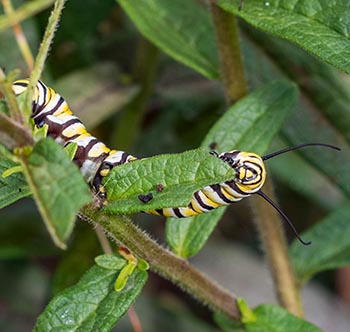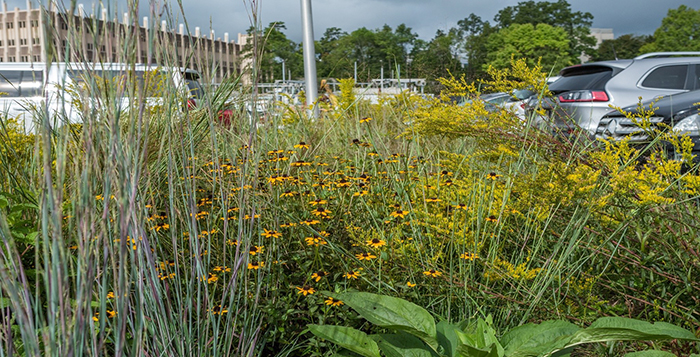Pocket Prairie
Welcome to the Parking Lot Pocket Prairie at Duke Hospital!
The staff of the Blomquist Garden of Native Plants at Duke Gardens created this pocket prairie to demonstrate that Southeastern native prairie plants can be an attractive, low maintenance alternative to sod in underutilized urban areas such as parking lots. Additionally, unlike sod, these pocket prairies can also be beneficial to pollinators such a birds and butterflies.

Many prairie grasses and wildflowers, like the ones you often see on the side of country roads and highways here in North Carolina, evolved to live in sunny, dry conditions. In the past, much more of the landscape of North Carolina was open grasslands dotted with wildflowers.
Because of this, we thought prairie plants would be suitable candidates as sod alternatives in urban medians. After all, what is drier and sunnier than a parking lot median?
For more information about piedmont prairies and the recreated prairie at the Blomquist Garden, click here.
The desired outcome for the pocket prairie was that the planting would act as both a demonstration garden for the public and conventional landscapers, and as an experiment for us, the gardeners, to see which species of native prairie wildflowers and grasses could best withstand the tough environmental conditions of the median, while still being attractive year-round. The selected plants needed to be able to handle receiving no supplemental water or fertilizer, and they were not taller than 3 feet, for ease of visibility across the parking lot.
We collected some of the seed from the wild and then grew most of the plants we used from seed on site at Duke Gardens. The remainder were purchased from two nurseries: Northcreek Nurseries and Hoffman Nursery.
The median was planted in two stages in 2019 and 2020. Sod was removed from two 90-foot-long sections of median with a sod-cutter and the holes were drilled with a gas-powered auger. The plants were then planted in the holes, watered once, and the whole area was mulched with composted hardwood chips. That’s it!

We used 22 different species of grasses and wildflowers (list below) in the pocket prairie and have been monitoring the site for attractiveness and the plants’ ability to withstand drought.
To our delight, we have seen many species of pollinators attracted to this spot in an otherwise fairly barren parking lot landscape.
We plan to continue planting the pocket prairie in stages in the next few years. We hope you enjoy this space and will consider using some of these plants in your landscape.
Plant List: Flowers
Gulf coast beardtongue - Penstemon tenuis
Foxglove beardtongue – Penstemon digitalis
Husker’s red foxglove beardtongue – Penstemon digitalis ‘Husker’s Red’
Slender mountain mint – Pycnanthemum tenuifolium
Narrow-leaf evening primrose – Oenothera fruticosa
Stokes aster – Stokesia laevis ‘Klaus Jelitto’
Georgia aster – Symphyotrichum georgianum
October Skies aromatic aster – Symphyotrichum oblongifolium ‘October Skies’
Brown-eyed Susan – Rudbeckia triloba
Black-eyed Susan – Rudbeckia hirta
Purple coneflower – Echinacea purpurea
Anise-hyssop – Agastache foeniculum
Roundleaf thoroughwort – Eupatorium rotundifolium
Sweet goldenrod – Solidago odora
Gray goldenrod – Solidago nemoralis
Downy lobelia – Lobelia puberula
Orange milkweed – Asclepias tuberosa
Whorled milkweed – Asclepias verticillata
Plant List: Grasses
Little bluestem – Schizachyrium scoparium
Standing Ovation little bluestem - Schizachyrium scoparium ‘Standing Ovation’
Blaze little bluestem - Schizachyrium scoparium ‘Blaze’
Splitbeard bluestem – Andropogon ternarius
Black Mountain splitbeard bluestem – Andropogon ternarius ‘Black Mountain’
Purple lovegrass – Eragrostis spectabilis
Bigtop lovegrass – Eragrostis hirsuta
Elliott’s lovegrass – Eragrostis elliottii

Additional resources
Pocket Meadows: Small Spaces with Huge Impacts
Photo information, from top: a monarch caterpillar happily feeding on orange milkweed (Asclepias tuberosa), photographed by Cathi Bodine; the parking lot median before and during planting, by Blomquist curator Annabel Renwick; the thriving Pocket Prairie, by A. Renwick; the H Lot Pocket Prairie fully grown in, by Cathi Bodine.






